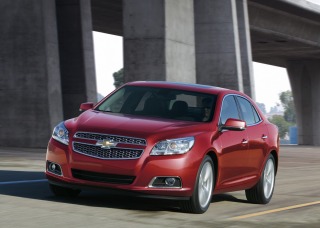
If the fuel-efficient Eco version is an indication, the 2013 Chevy Malibu will follow in the brand’s newfound tradition of comfort, quietness and composure.
With the redesign of its Malibu midsize sedan for the 2013 model year, Chevrolet is close to coming full circle. The 2008 Malibu redesign proved that the quintessential American brand knew how to build a competitive car, and the company has since fleshed out its lineup with the Camaro sports car and Cruze compact — both hot sellers — the Volt plug-in hybrid and a new Sonic subcompact. All of these models have continued the viable-product offensive, leaving behind the era of offensive products. Only the full-size Impala and, to a lesser extent, the Corvette have yet to be dragged into the 21st century.
Why did Chevy launch such an important new model in a version that’s likely to be its least popular? Because GM CEO Daniel Akerson didn’t want to wait while the Hyundai Sonata continues snatching market share, the recently redesigned Toyota Camry and Volkswagen Passat solidify their toehold, and a rebaked Ford Fusion is just about ready to pop out of the oven. I don’t blame him.
As for the Eco, well, it was the first one ready; its drivetrain is essentially shared with the Buick Regal eAssist, though the Malibu doesn’t get the eAssist name. After the Eco’s spring launch, an all-new 2.5-liter and turbocharged 2.0-liter engine, both four-cylinders, will follow later in 2012. A V-6 is not planned.
The Eco employs a mild hybrid system that’s closest in principle to Honda’s technology in that the electric motor-generator is always in motion with the gas engine, in this case a 2.4-liter four-cylinder, and is teamed with a more conventional transmission. The eAssist battery and motor-generator are much smaller, though, as is the resulting mileage gain. Chevy estimates city/highway mileage at 25/37 mpg.
Because the Eco starts at $25,235 and will ultimately represent relatively low volume, I’ll lead off with the shared characteristics before closing with a drivetrain evaluation.
Exterior & Styling
At 191.3 inches in length, the 2013 Malibu is just a half inch shorter than the 2012 but is almost 3 inches wider, which pays dividends inside. One yellow flag is the wheelbase decreased 4.5 inches from the previous generation, a change that seldom benefits a car’s looks, cabin space or ride quality.
Upon the Cruze’s debut, I foresaw trouble for the plain sedan in a class with the stylish Ford Focus and Hyundai Elantra, but throngs of buyers have proved me wrong. There’s always room for a modest but inoffensive design, and the Malibu is better than modest and, by most accounts, inoffensive. The affordable midsize sedan class isn’t known for cutting-edge styling, though cars like the Kia Optima and Hyundai Sonata definitely stand out, and the soon-to-be-released Ford Fusion redesign is expected to follow in the Focus’ edgy footsteps.
We expressed our uncertainty about the Malibu’s styling — particularly its rear end — at the 2011 New York International Auto Show. It definitely looks better out in the wild than it did in captivity.
In sculpting the Malibu, its designers drew upon the Camaro, whose influence is best seen in the C-pillar, haunchy rear fenders and taillights, and some interior touches. I’m not sure I get it. Frankly, the best aspects of the Malibu have nothing to do with the Camaro influence. The taillights seem forced, and of all the Camaro’s elements, the gauges are one of the last I’d carry over. Also, the proud trunk lid has a dormer look reminiscent of BMW’s most awkward period in the 2000s. Baffling.
The Eco has aerodynamic provisions that will be featured on some but not all other Malibu trim levels, but they’re mostly invisible: underbody treatments, active shutters in the lower grille that close at higher speeds to lessen drag, etc. The only exterior designation, then, is an “eco” badge on the trunk lid. Though it’s technically a hybrid, Chevy will no longer use that word. Seventeen-inch alloy wheels are standard.
The Inside
Though inspired by the Camaro, the Malibu doesn’t share that car’s outrageously bad sightlines. The roof is reasonably high, the C-pillars are thick but not too obstructive, and though the A-pillars extend forward far enough to block the driver’s view occasionally on winding roads, that’s becoming the norm in the marketwide quest for aerodynamics.
I was pleased to find the front seats comfortable — never a guarantee in GM cars (witness the Buick LaCrosse and Cadillac CTS). It’s also reasonably roomy, with 2 cubic feet more passenger volume than in the 2012. The headroom and legroom changes are no greater than 0.4 inch versus the 2012 model. The passenger’s seat has exceptionally long travel: With it adjusted all the way back, my legs were almost straight out in front of me. Shoulder room and hip room have increased 1.6 and 2.7 inches, respectively, and you appreciate it.
The same is true in the backseat, where the difference is even greater. The headroom is also up 0.4 inch, but sadly the legroom has come down 0.7 inch to 36.9 inches, relatively low for this class — possibly a sacrifice of the shorter wheelbase. At 6 feet tall, I found it workable regardless, contingent upon the front seat’s position, but I’d prefer if the seat were higher relative to the floor. On the upside, the center floor hump is just above ankle height — not the worst out there.
I rode around awhile in the backseat and found the ride comfortable and quiet, as I did in front. The shorter wheelbase seems not to have hurt the Malibu in this regard. As we’ve noted in many reviews of late, Chevrolet has become adept at both ride comfort and a hushed cabin. For quietness, the Malibu might be the best yet. Wind noise is practically non-existent, with no predominant source of sound, even from the side mirrors. (Unfortunately the aerodynamic imperative might be behind their too-small size.) Laminated front-door windows effectively combat passing-vehicle noise. Most of what you hear is road noise, which is low enough in frequency not to interfere with conversation. Even wet roads didn’t produce much of a disruption.
Handling
The slick pavement did disrupt roadholding tests, but my overall impression of the car’s dynamics is positive. The body motions are well-controlled and it just feels like it will be a capable front-drive platform in lighter-weight versions fitted with more power and tires optimized for grip rather than efficiency. The new electric power steering is also impressive, comparable to the best work from Ford and others. It’s a far cry from the earliest effort by GM — a pioneer in electric steering assist — that graced, or disgraced, the original Saturn Vue.
Cabin Quality
My impressions of the Malibu’s interior quality are mixed. I have to qualify my reservations for two reasons: The cars I tested were pre-production and, because they were all the Eco trim level, there was little variation in the interior appointments. Each combined blacks and grays with brown imitation-wood trim, a mix I always find discordant. I also have little tolerance for silvery plastic that fails to look like metal. It ringed the center control panel, console and gauges.
Another peculiarity is the band of vanes that run across the dashboard from one door handle to the other, incorporating two of the air vents. The vents are normally sized; the rest of the trim just looks like a grille. A central chrome strip reflects blue accent lights tucked under the dashboard cover — a nice touch — but the whole design element is too prominent, or perhaps I should say dominant. Air-conditioning vents aren’t the prettiest aspects on a dashboard; do we really want to see them extended rather than minimized?
On the upside, the deeply-grained padded surfaces look great, the door release handles are chromed, the headliner is a woven material and there’s sparing use of piano-black trim. There’s a high-resolution color screen between the gauges that displays everything from trip information and navigation prompts to the hybrid system’s power flow.
The Malibu also improves on the Cruze with its more logical button layout and a few appropriate features controlled by rotary knobs, which have a quality feel. Unfortunately, there’s no feel whatsoever to the “capacitive” touch-sensitive buttons on either side of the touch-screen in cars equipped with optional navigation. (Anyone want to place bets on how long it will take for automakers to abandon this misguided “advancement?”)
The touch-screen is standard on the Eco, supporting entertainment functions as well as nav. In both cases, a release switch below the screen allows it to spring upward, revealing a storage compartment. I support its inclusion solely because the storage bin under the center armrest is quite small — fist-sized and pretty far back, and its respectable depth is easily obstructed by anything plugged into the high-mounted USB port or 12-volt outlet.
The display-as-door execution troubles me more than motorized screens do. You close this one by hand and, frankly, it feels a bit flimsy. Turning an expensive component into a manual storage lid strikes me as a bad idea. Would I take a stationary LCD in exchange for a roomy bin under the armrest? Absolutely.
MyLink
The touch-screen is one means of controlling Chevrolet’s MyLink, which the Malibu introduces. Comparable to Ford’s MyFord Touch and Toyota’s Entune, MyLink is an integrated approach to controlling entertainment and communication. Like those, it also features voice activation.
Though Chevrolet offers XM Satellite Radio and OnStar, the latter of which has its own cellular hardware, the company designed MyLink to work with the personal cellular devices people prefer to use. Like Entune and Hyundai’s new Veloster model, MyLink supports internet radio, received by the smartphone and then shared with MyLink either by means of a cable or Bluetooth wireless connection (which one it is depends on the phone).
The stereo’s source button cycles among all the available options, including AM, FM, XM, Pandora, Stitcher and any connected music player or USB drive — regardless of the fact that the source material originates from many different areas. If the Pandora application is running on a paired phone, MyLink will pick it up. MyLink duplicates the basic Pandora functionality on the touch-screen, allowing the user to press thumbs-up or -down for any song. You can even register your vote by voice command.
Naturally, MyLink also displays artist and title information as well as album art, though the source of this content varies. In some cases it’s pulled directly from the smartphone. In others it comes from the onboard Gracenote feature. It all depends on the type of phone, which app or storage medium the music or podcast is coming from and how it’s connected. (Chevy tried to explain it all, but I nodded off. Ask your dealer.)
OnStar Navigation
If you don’t want to spend an additional $1,200 for the proper navigation system (along with memory seats and mirrors), you don’t need to. OnStar’s Turn-By-Turn Navigation has become a compelling alternative. In cars that aren’t equipped with the onboard navigation system, drivers can press the OnStar button and ask a live operator to be routed to a destination. OnStar then transmits the course to the car, which presents turn-by-turn guidance — complete with arrows and distance-to-turn progress bars — on the display between the gauges and/or on the 7-inch touch screen.
The arrow is even incorporated into some other menus such as the XM radio information screen. It also provides the familiar voice prompts and beeps and pronounces street names understandably. This feature has come a long way since I first experienced it, coincidentally, in the Eco’s forebear, the Malibu Hybrid. There it relied on a crude little LED display and had a speech impediment so bad it turned “I-80 East” into “Eye-deest.”
All that’s really missing compared with a conventional navigation system are the map and a time-to-destination readout. The feature requires OnStar’s Directions and Connections plan, which requires a subscription after a six-month free trial.
eAssist Drivetrain
Just as this mild hybrid’s cost and mileage gains are between those of regular cars and full hybrids, so is its driving experience. It feels a bit different from a regular gas-powered car, but it’s not prone to surging, ill-timed droning noise or inconsistent braking — some or all of which plague full hybrids. It has automatic engine start/stop, but it works only when the car has come to a stop, turning the engine off and on smoothly.
Unlike full hybrids, the eAssist’s motor-generator is smaller and ties into the drivetrain by means of a belt. It looks like and takes the place of an alternator, though this new generation is liquid-cooled and capable of 15 horsepower. The power and torque of 79 pounds-feet help accelerate the car and also allow it to use a lower final-drive ratio than the eventual gas-only model, for lower engine speeds and higher efficiency at all times. Chevy cites a zero-to-60 mph time of 8.7 seconds for the Eco.
The car’s use of a six-speed automatic makes it feel and sound like a conventional car, and that’s good, but it’s not without quirks. I noticed a slight shudder when lifting abruptly off either the accelerator or the brakes. We detected the same in the Regal with eAssist. To be clear, most drivers wouldn’t notice this or wouldn’t mind. If people can live with a full hybrid’s quirks, they can certainly deal with this.
The brakes also feel better than the average hybrid’s. Though the car is working to regenerate electricity as you brake, it feels pretty linear. The eAssist motor is used to smooth downshifts, so it’s much better than the BMW Efficient Dynamics system to which we objected in the 5 Series. I questioned the brakes’ overall stopping power, though, because it seemed I was always applying more and more pressure, but I later theorized it was because the car is so quiet, I didn’t recognize how fast I was going and was braking late.
Even so, I was surprised a car designed to recapture energy like this didn’t exhibit more engine braking than the Malibu Eco does. It feels like it wants to keep going. If you consistently want more deceleration when you lift your foot, you might have to resort to the transmission’s manual mode, which lets you select a lower gear via a rocker switch atop the shifter.
Unfortunately the Eco’s drawbacks go beyond a few quirks and the added cost of eAssist: The 115-volt battery pack and associated electronics and cooling steal 2 cubic feet of trunk space for a total volume of 14.3. It’s not too bad, though, because the 2012 Malibu’s trunk is 15.1 cubic feet without eAssist. The regular 2013 Malibu will have 16.3.
The battery arrangement also reduces the split, folding backseat to a pass-through that’s wider but not much larger than the type you sometimes find behind a backseat’s armrest. This might be the only step back from the old Malibu Hybrid, which maintained almost the full trunk width, if not height.
Safety
As of this writing, the Malibu hasn’t been crash-tested. The Malibu has eight airbags, including the frontal pair, a knee airbag and seat-mounted side-impact torso bag for each of the front occupants, and side curtains for the front and rear occupants. As required since the start of the 2012 model year, the Malibu comes standard with antilock brakes and an electronic stability system with traction control.
A backup camera comes in an option package. OnStar is standard with six months’ free subscription. Chevrolet says forward collision alert and lane departure warning will become available later in the year.
Malibu in the Market
Though I drove only one powertrain in one trim level, I can see how much promise the 2013 Malibu holds. Automakers have one chance to get the basics right — things like ride, handling and noise abatement — and Chevrolet definitely has. Providing that the future drivetrains are done right, the Malibu will help round out Chevrolet’s car lineup. When a brand has a full line of quality cars of different sizes and prices, the chance is far greater that a shopper will leave a dealership with something. What’s less clear is if shoppers will deem the mileage worthy of the Eco’s higher price. That will be determined, in part, by how efficient and affordable the base Malibu turns out to be.
Snapshot:
Starting MSRP: $25,235–$26,845
MPG
City: NA
Highway: NA
Available Engines
182-hp, 2.4-liter I-4 (gas hybrid)
Transmissions
6-speed automatic w/OD and auto-manual
New or Notable
n/a
What We Like
n/a
What We Don’t
n/a



































